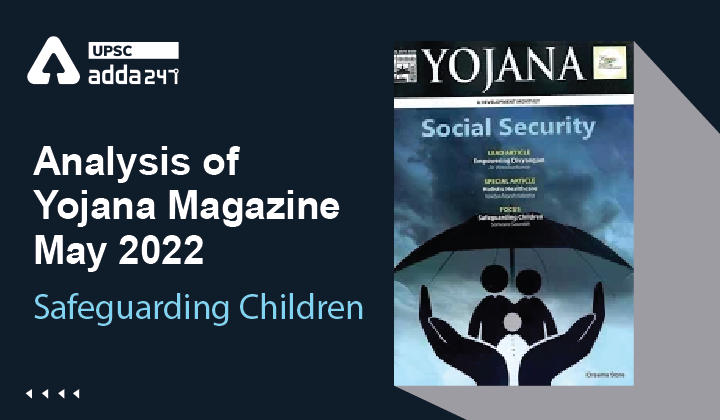Table of Contents
Analysis Of Yojana Magazine
”Safeguarding Children”
Introduction
- As per the census 2011, there are 472 million children below the age of 18 years and comprise 39 per cent of the total population.
- According to the United Nations Children’s Fund(UNICEF), India has 29.6 million orphaned and abandoned children
Child Protection Services (CPS)
- The child Protection Services (CPS) Scheme is a centrally sponsored scheme under which support is provided to States and UT Governments for delivering services for children in need and in difficult circumstances.
- The Child Care Institutions (CCIs) established under the CPS scheme support inter-alia age-appropriate education, access to vocational training, recreation, health care, counselling etc. and equally covers rural and urban children.
National Commission for Protection of Child Rights (NCPCR)
- It is an autonomous body under the aegis of the Ministry of Women and Child Development, is entrusted with the mandate to ensure that all Laws, Policies, Programmes, and Administrative Mechanisms are in consonance with the Child Rights perspective as enshrined in the Constitution of India and also the UN Convention on the Rights of the Child.
- Various activities are taken up by the NCPCR along with the State Commission for the Protection of Child Rights (SCPCRs) through consultation, webinar, developing of creative material with reference to children rights, well being, nutrition etc. from their allocated budget.
PM CARES for Children scheme
- The PM CARES for Children Scheme was launched by The Hon’ble Prime Minister of India on 29th May 2021 for the Children.
- It aims to support children who have lost both the Parents or legal Guardian or Adoptive Parents or Surviving Parent to COVID-19 pandemic during the period starting from 11th March 2020.
- The objective of the Scheme is to ensure comprehensive care and protection of Children in a sustained manner, and enable their well being through health insurance, empower them through education and equip them for self-sufficient existence with financial support on reaching 23 years of age.
Central Adoption Resource Authority (CARA)
- It is a statutory body of the Ministry of Women & Child Development, Government of India.
- It functions as the nodal body for the adoption of Indian children and is mandated to monitor and regulate in-country and inter-country adoptions.
- CARA is designated as the Central Authority to deal with inter-country adoptions in accordance with the provisions of the Hague Convention on Inter-country Adoption, 1993, ratified by Government of India in 2003.
- CARA primarily deals with the adoption of orphan, abandoned and surrendered children through its associated /recognised adoption agencies.
Mission POSHAN 2.0
- It is an Integrated Nutrition Support Programme.
- It seeks to address the challenges of malnutrition in children, adolescent girls, pregnant women and lactating mothers through a strategic shift in nutrition content and delivery and by creation of a convergent eco-system to develop and promote practices that nurture health, wellness and immunity.
- Poshan 2.0 will seek to optimize the quality and delivery of food under the Supplementary Nutrition Program.
Mission Vatsalya
- Mission Vatsalya Children have been recognized by policymakers as one of the supreme national assets.
- The objective of Mission Vatsalya is to secure a healthy and happy childhood for every child in India; foster a sensitive, supportive and synchronized ecosystem for development of children; assist States/UTs in delivering the mandate of the Juvenile Justice Act 2015; achieve the SDG goals.
Conclusion
There needs to be a huge readjustment in the government’s focus on child development because currently, millions of children are being denied opportunities to live a life of safety and good health.



 TSPSC Group 1 Question Paper 2024, Downl...
TSPSC Group 1 Question Paper 2024, Downl...
 TSPSC Group 1 Answer key 2024 Out, Downl...
TSPSC Group 1 Answer key 2024 Out, Downl...
 UPSC Prelims 2024 Question Paper, Downlo...
UPSC Prelims 2024 Question Paper, Downlo...




